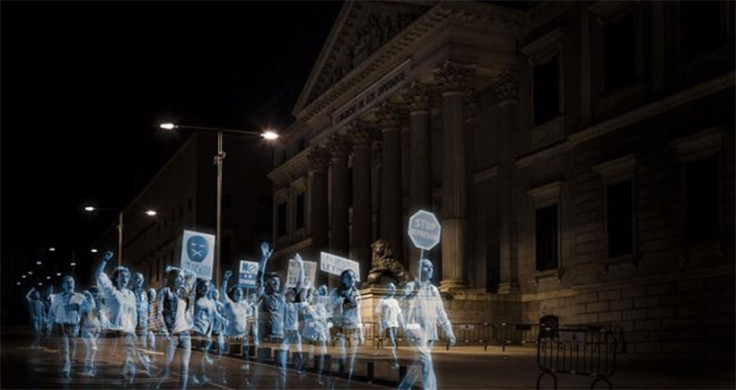Spanish hologram protesters: 'Virtual reality demo was our only option'

The world's first protest using holograms instead of people took place in Spain over the weekend in response to a new anti-terror law.
The event was organised by No Somos Delito following several months of protests against the controversial Citizen Safety Law, which has also been referred to as the 'Gag Law'. The legislation, due to come into effect in July, means protesters gathering outside government buildings in Spain will be issued with heavy fines.
But how did the protest work? What are the main concerns about the gag law'? And what does the future hold for hologram protests in Spain? To find out, IBTimes UK interviewed Monica Hidalgo, of No Somos Delito. Here's what she told us:
How did this all start?
We wanted to organise a rally against the a series of new "gag laws" that the Spanish government has recently approved and that put heavy restrictions of freedom of expression. We were put in contact with an advertising and production company who want to remain anonymous and the idea came up. We thought it was the only way of protesting without being fined.
What's your main concern regarding these 'gag laws'?
For example, the Spanish Government recently approved the Law for Citizen Safety, which allows the deportation of migrants intercepted on the borders of Ceuta and Melilla. That's unacceptable and criminalises poverty instead of helping migrants.
In December they approved the public security law, also known as the 'gagging law'. This law allows fines of up to €600,000 to individuals participating in demonstrations outside parliament buildings or key installations or €30,000 for attempting to prevent home repossessions.
What do you think the majority of Spanish people think?
Well, if you look at the surveys of people's most common worries, in Spain it is unemployment and corruption, and not the fact that there is a group of neighbours protesting and trying to avoid an eviction.
How did the protest work?
We launched a website, Hologramas por La Libertad (holograms for freedom) 15 or 20 days ago. There you could upload your photo to be part of the crowd at the demonstration. You could also record and write the messages that appeared and were shouted in the protest.
How successful do you think the event was?
We are very happy and proud of what we have done, and also surprised. Especially the impact it has had internationally. We have appeared in the international media, almost everywhere, and there have been many more international reactions than national.
Do you know if it was the first hologram protest in the world?
Yes, I think it is the first manifestation of holograms in the world, to our knowledge nobody has done it before.
Do you think the Spanish government will ban hologram protests?!
If they had known previously, they would definitely have banned demonstrations with holograms!
You must be proud but at the same time kind of sad that you had to protest this way to avoid being fined.
Yes, I agree, but it has helped to draw attention to what's happening in Spain. I think the protest was a little wake-up call alerting Spain to the nonsense of a future without street protests. Not being able to protest on the street for fear does not fit in a democratic country.
But will you do it again?
In our case, it was the first and the last holographic protest. From now on, we will take to the streets. We will not stop going out despite the administrative penalties or imprisonment threats.
It was a very nice and original protest with holograms, but we will go back to the streets. The rights shouldn't be defended but exercised and the only way to preserve our rights is exercising them.
© Copyright IBTimes 2025. All rights reserved.





















